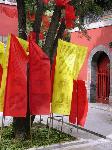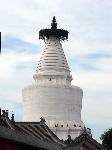- Getting around Lijiang. Dont stay in the Old Towns more than 2 days, there is nothing to do. KRISS Oct 9, 2013 05:46
- 2013 Beijing Temple Fair BENNYLAU Feb 26, 2013 03:29
- Malaysian traveling from KUL - LAX vis Shanghai PVG ZATI_DY Jan 3, 2013 20:15
Twenty-eight Yuan Tourism at Fuchengmen
- Views: 4377
- |Vote: 0 0
- |Add to Favorites
- |Recommend to Friends
The Hutongs of Northwest Beijing
Beijing’s legendary poor traffic conditions are a major source of frustration for residents and visitors alike. Despite the long, straight, broad streets intersecting and encircling the map, an unimaginable number of vehicles manage to clog and back up many of these great boulevards every day, and journey times can be way out of proportion to physical distance. It can take longer to cross the breadth of Beijing than it does to travel all the way to the neighbouring city of Tianjin on the highway, and it’s not uncommon to spend a full twenty minutes trying to cross one intersection. In Beijing, never make the mistake of thinking that a taxi ride will save you some time; taxis always take the most obvious routes, placing them right in the middle of the thickest traffic every time.
In conditions such as these, it’s fortunate that Beijing’s subway system is so reliable. The main lines may be without air conditioning and are often crowded, but the speed and frequency of the services are lifesavers when the need arises to get across the city in the shortest time. Good news too is that Beijing is tripling the number of its lines, linking such remote sites as the airport, the south railway station and the Summer Palace into the network.
Beijing’s subway system not only connects tourists with such well-known locations as Tiananmen, the Forbidden City, Wangfujing Shopping Mall and the Lama Temple, but it also brings less well-known attractions within easy reach. For any visitor wishing to spend a relaxing and interesting afternoon exploring lesser-known Beijing without spending much cash, one good option is to get a three yuan ticket for Beijing’s Circular Line 2 and step off at Fuchengmen. Leave the station via the northeast exit and you’ll find yourself in a seemingly nondescript patch of suburban Beijing – you wouldn’t think it, but you’ll be within walking distance of some fascinating and colourful places that most tourists will never get the chance to find.
There’s a long road stretching towards the east called Fuchengmen Nei Dajie (Inner Great Fuchengmen Street) – set out down that road, and within moments you’ll come to an alleyway that turns to the north. Not only is this alley an entrance point to the great warrens of traditional hutongs of northwest Beijing, it’s also a short drive leading directly to the homestead of prominent Twentieth Century Chinese literary giant Lu Xun, for whom the hutongs were the neighbourhood of his elegant home, now a museum left in his honour.
Many people are under the impression that Beijing’s hutongs are some kind of tourist installation located somewhere in Beijing, and I’ve been asked before to point out where they are on the map. In fact, the word hutong merely means ‘alley’, and refers to the complicated maze of traditional homes and networks of old stores and courtyards that are left over from the old Beijing before modern times. There are several districts in Beijing where the hutongs remain relatively untouched – areas around Qianmen, Dongzhimen, the Drum Tower and here in Beijing’s northwest are good sites for exploring the look of an earlier age – but they are rapidly disappearing with Beijing’s ever-accelerating development. You could wander about this area around Lu Xun’s mansion for hours and soak in some authentic Beijing without spending a cent, and feel you’ve had an impression of the real China you may not be able to find in the usual tourist haunts.
Lu Xun’s mansion museum itself is well worth the five yuan entry fee. Open every day except Monday and closing at 3.30pm, the museum holds hundreds of his personal effects and manuscripts of his work. Lu Xun’s clear, simple and prosaic style makes him just as appealing in translation as he is in the original Chinese – the socialist administration has made him an icon of realism and the voice of twentieth century China, in contrast to the gentrified and pretty poetry of less socially-minded ages. Lu Xun lived here whilst teaching at the Beijing Women’s University, having given up a career in medicine in favour of pursuing a more widespread treatment of social ills through literature. He managed to make himself out of favour with the contemporary Nationalist government and had to flee to Shanghai where he died seventy years ago. The works he wrote in this mansion are now considered classics, and are enjoyed throughout the nation.
The White Pagoda Temple
Stepping back on Inner Great Fuchengmen Street, continue walking to the east, and within several minutes you’ll find yourself at the rather impressive gate of an unusual-looking temple. Whilst the front yard follows a thoroughly standard layout, you’ll find the central attraction – an enormous Lamaist dagoba – a genuine curiosity, poking up out above the hutongs like a gigantic ice cream cone.
The pagoda is the master work of the Nepalese national hero Arniko, a craftsman commissioned by the ruling Yuan Dynasty to design the tower as the crowning point of the Imperial capital of Dadu, situated on what is now Beijing. At the time, the Mogolian Dynasty had been ruling China and most of the Eurasian continent since Ghenghis Khan’s hoardes of tribesmen on horseback had brought the entire region to its knees. The Mongolians were adherents to the Tibetan Lamaist faith, and in the interests of political unity as well as religious belief, the dagoba was constructed to be the tallest structure in the new capital.
Kublai Khan supervised the construction of the tower in 1271, and in the following year arranged for a temple to be built at its base, which he called the Dashengshouwan’an Temple. The boundaries of the sacred ground were determined by the firing of arrows in four directions from the base of the tower, which served to mark the position of the temple walls where they fell. The temple design incorporated Han stylistic elements, resulting in an edifice that would have been thought to pacify all peoples throughout the empire. Tibet in particular had recently been formally incorporated into Chinese territory after the establishment of diplomatic ties forged by Tibetan Sakya Pandita Aka Sa-Pan and the Commanding General Godan of the Mongolian Western Route Army in Chinese Liangzhou. Thus the pagoda held important political significance at the time of its construction and its stated purpose was “To maintain a permanent state with the support and protection of the holy dragon”. Despite the grandeur of its purpose, the great Yuan Dynasty was only to last another 90 years, after which China reverted to Han control and the Chinese culture slowly began a long period of cultural seclusion.
Interestingly enough, many years later in the Qing Dynasty, another period of foreign rule in China, the Imperial seat faced a similar problem of how to pacify and unite the unstable Mongolian and Tibetan factions so as to maintain a stable control of the empire. In those times, the White Pagoda Temple resumed its earlier political significance, and under Emperors Kangxi and Qianlong, the by then aging structures underwent considerable repair, and the tower once again became a star attraction of the capital city that served both diplomatic and religious ends.
This temple was one of the many parts of Beijing to be damaged by invading European powers early last century, and again by invading Japanese troops. It wasn’t until long after the establishment of the Republic of China that the temple was restored in 1937, by which time it had become something of a cultural centre where rowdy and exuberant temple fairs were held, right in the middle of all those hutongs of which many survive today. The fairs had been financed by the sale of artefacts by resident Lamas, and in fact the temple had become reasonably wealthy. However, temple activities fell off after the foundation of the current Chinese administration, and in the 1960’s became a cultural relic that enjoys studious protection and preservation to this day.
Nowadays the temple is a fascinating museum, hidden in the Fuchengmen area and charging a twenty yuan admission fee. The temple is moderate in size, and features a fascinating historical museum, a massive central hall filled with thousands of Tibetan Buddhas on display, and a collection of etchings representing towers of significance all across the country. The dagoba itself is sectioned off by a protective fence, but can be admired up close from just beneath from all sides. All in all, the site is a marvellous relic that is well worth taking the short stroll from the subway to see.
However, if you have taken the opportunity to explore Fuchengmen district at such a low cost and are starting to feel guilty at your own stinginess, there’s a perfect opportunity to blow your budget right at the White Pagoda Temple door. Just to the left off the courtyard in front of the ticket gate is a small entryway leading to one of Beijing’s most charming traditionally-styled restaurants, known as the ‘Temple Kitchen’. The restaurant is constructed in old temple buildings and has been immaculately decorated, with dining rooms in separate halls joined by walkways and bridges crossing a large pond of brightly coloured goldfish. For the fabulous cost of a fabulous meal, diners can relax where the Emperors themselves studied and contemplated matters of state and of faith – and for those with a taste for class as well as a passion for history, this is a meal that will be remembered as a culinary highlight of any trip to China.
Reservations: (8610) 66171119 / 66181119 – www.guangronghui.com





 Copyright © 1998-2025 All rights reserved.
Copyright © 1998-2025 All rights reserved.